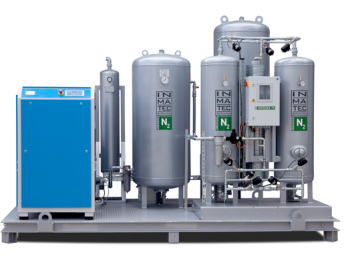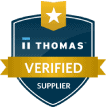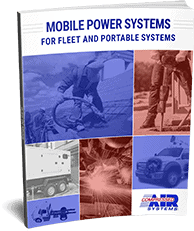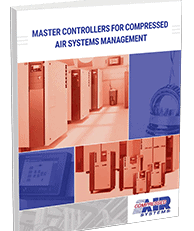Nitrogen Generators for the Food Industry
Pure nitrogen plays a critical role in ensuring optimal consumer safety for all types of perishable foods. Used for both the transportation and storage of food products, nitrogen allows for efficient, economical preservation, locking in freshness and flavor while safeguarding human health.
Nitrogen is the dominate gas in atmospheric air, but food freshness can be affected by even small amounts of oxygen, which allow harmful microbes, such as bacteria, to flourish. Therefore, nitrogen-rich environments with no more than 2% oxygen by volume are ideal for the processing, packaging, and storing of food products. In fact, nitrogen generation is employed in almost every step of food processing operations.
Air Filtration, Nitrogen Processing and Atmospheric Packaging
 In order to limit the risk of recalls and the potential to affect the health of end-users, it is critical to make sure that proper air filtration systems are in place at the beginning of any food packaging processes. These systems ensure that air is free of contamination and moisture before it moves onto other packaging processes. Additionally, these systems serve to prevent costly downtime that can occur when contaminated air enters sensitive systems, and they can also reduce energy consumption.
In order to limit the risk of recalls and the potential to affect the health of end-users, it is critical to make sure that proper air filtration systems are in place at the beginning of any food packaging processes. These systems ensure that air is free of contamination and moisture before it moves onto other packaging processes. Additionally, these systems serve to prevent costly downtime that can occur when contaminated air enters sensitive systems, and they can also reduce energy consumption.
Atmospheric air that is pulled into compressed air systems can fill a system with contaminants that include water vapor, micro-organisms, oil vapor, and atmospheric dirt. These contaminants can rapidly decrease system output, contaminate foods, and trigger recalls and health implications. To combat these issues, several filter systems are used including water separators, coalescing filters, and compressed air dryers, and dust removal filters.
Oil-free or Oil-less Air Compressors
Oil-free or oil-less air compressors are becoming more prevalent in the food industry. “Class-zero” air means that there is no oil in the air. Only one inline filter is needed to capture any possible hydrocarbons or other contaminants the compressor may ingest. Although the upfront costs are higher with oil-free compressors, the maintenance over the life of the compressor is much less as parts such as oil filters, separators, and oil are not needed.
Once atmospheric air has been effectively filtered in food production facilities, it moves onto the nitrogen generator systems. Producing nitrogen onsite at food processing, production, and packaging facilities can allow for savings of up to 75% of the total costs associated with nitrogen delivery. On-site nitrogen production systems take in compressed atmospheric air and strip out the oxygen and moisture to produce clean, dry nitrogen with purity levels as high as 99.99%. Below are the two primary types of systems, pressure swing adsorption (PSA) nitrogen generation systems and nitrogen membrane generators.
- PSA Nitrogen Generators — These systems actually employ two alternating processes, purification and regeneration.
- Purification — The first step involves drawing air into the system for immediate filtration in order to remove large air particulates. The air then passes through dryers to remove most of the water vapor from the air. Next, the air goes through a device called a carbon molecular sieve, which removes the remaining water and oxygen molecules from the air. The nitrogen is then redirected to a separate buffer vessel for further filtration before making a return trip to the instrumentation compartment of the PSA generator. Here, final pressure and flow rate adjustments are made in order to tailor the gas for the intended application.
- Regeneration — After a period of extended use, the carbon molecular sieve becomes saturated with absorbed oxygen, and the system requires the absorbed oxygen to be removed from the sieve in the regeneration phase. This is accomplished by diverting some purified nitrogen gas from the buffer vessel back to the sieve. The nitrogen gas is expanded to standard atmospheric conditions, in which the oxygen is able to remix with the nitrogen. This gas is then expelled from the system via a simple exhaust valve.
- Nitrogen Membrane Generators — Nitrogen membrane generators, on the other hand, consist of hollow membrane fibers that bundle together to physically separate the molecules. After separation from the nitrogen, the oxygen is vented to an exhaust system while the captured nitrogen is diverted to a separate storage system. This type of nitrogen generation is far more effective for smaller applications, as the filter does have a finite life span. Additionally, there is no mechanism to “regenerate” the filters, as there is with PSA generators.
Are you ready to learn more about the different nitrogen generation processes and how to effectively select and manage the right generator for your application? Download your Guide to Nitrogen Generation today.
Atmospheric Packaging
Nitrogen gas is also employed in modified atmosphere packaging (MAP) processes, a preservation technique designed to introduce different types of gases into a package based on the needs of the specific product at hand and its required storage temperature. MAP changes the composition of the air surrounding food products, ensuring that food stays fresh and free of moisture and bacteria. And because MAP fills the empty space in food packaging, products are better protected during shipping. Two different MAP methods can be used, passive and active.
- Passive MAP — This method involves packaging food at normal atmospheric conditions, with the goal of developing the packaged gas medium naturally as a consequence of the products’ respiration and the diffusion of gases through the packaging film.
- Active MAP — In contrast, this method involves the direct displacement of atmospheric gases in the food package. These gases are then replaced by the desired nitrogen gas composition.
Active and passive MAP methods are used for a wide range of applications, including barrier packaging films, gas flushing, and integrated package valves. In gas flushing, for instance, nitrogen is commonly used to reduce the amount of ambient oxygen in a food package. The gas is pumped in to displace the oxygen, thereby delaying oxidation, decreasing the growth of aerobic spoilage organisms, and serving as a filler to ensure package conformity.
Accomplishing Effective Packaging with Vacuum Pumps and Systems
Vacuum pumps also play a large role when it comes to effectively packaging food goods using MAP. These vacuum pumps are the driving tool used to remove excess air and insert the nitrogen that has been generated earlier in the process, and then to seal the packaging. Finally, vacuum pumps are also employed to help transport both packaging materials and food goods through each step of the packaging process.
Some of the common processes vacuum pumps are used for in food packaging include:
- Filling and closing packaging
- Forming packaging
- Tray and package sealing
Learn More
At Compressed Air Systems (CAS), we provide a range of nitrogen generating solutions, air filtration solutions, and vacuum pump systems. We also offer nitrogen analyzer instrumentation to ensure optimal gas purity and quality. To learn more about our nitrogen generation equipment or discuss the benefits of nitrogen for food processing operations at your facility, reach out to the team today.









